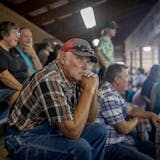With its great brick expanse, the Minnesota State Fair Grandstand was built for the ages. It looks as if it’s always been there and will always be.
But the fair is a building graveyard without headstones. Many of the structures we think of as venerable, including the grandstand we know and love, replaced something that looked permanent 100 years ago.
Like the human body, the fair is constantly replacing itself on the cellular level while still maintaining its familiar appearance. And like the human body, it’s full of corn dogs — and history.
The classical period
In the early years, the fair was largely built from wood. The food booths were wood with cloth banners. The gazebos were wood. Even the first grandstand was made of wood.
From 1900 to the crash of ’29, many fair buildings took shape. The Hippodrome was built in 1906 for livestock judging and shows. In winter, it also housed an ice rink. It was demolished after World War II, when it was used as a propeller plant.
The Dairy Building, built in 1907, is now the Fine Arts Center. It’s the oldest building on the fairgrounds, along with its 1907 cousin, the Poultry Building (now the Progress Center.)
The grandstand is the highlight of this period, of course. Built in 1909, it’s the third structure on the site. Early drawings of the building show tower-like protuberances on each end.


